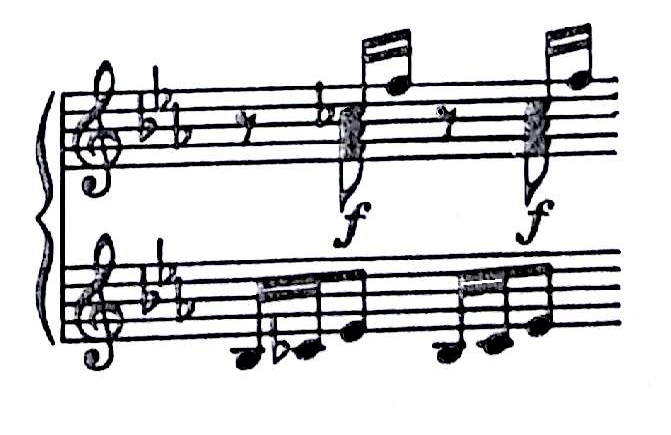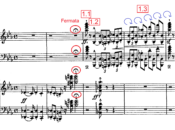Masterclass by Vladimir Ashkenazy
Perhaps the most important and crucial point in understanding this piece is that although it was conceived initially as a programmatic cycle, the result is music that not only goes far beyond mere descriptive qualities but in fact gives us a penetrating insight into the dark and brooding spirit of Mussorgsky – or for that matter of Russia itself. Indeed everything in his music – including Pictures – is seen through and by the eyes of a human being in the midst of the narrative. If the potential performer keeps this in mind and realizes how much good and evil, tragedy and triviality, fairy tale and stark reality are contained in this opus, he will be on the path of realizing the composer’s intentions. Conversely, if he treats it simply as a piece of entertainment, then his hard work (it is a difficult piece!) will be in vain and he is doomed to failure.
Having said that after this introduction, I shall leave the rest to the imagination of the individual performer and will limit myself only to dealing with some practical observations which hopefully may be of help to some and of interest to others.
Promenade. Make sure the upper voice is clear and distinct in bars 3 and 4 and indeed keep the melodic line very well projected. Attention to dynamics is especially advisable considering the relative monotony of the material: bar 9 could be mf, then bars 11-12 crescendo and bar 13 forte; then perhaps dim. in bars 14-15-16, the crescendo starting in bar 17 culminating in forte at the end of bar 21 and then ff in bar 23, fourth beat.
Gnomus. Articulation is the essence of the basic motive. Therefore the tempo should be dependant on how fast the low register can “speak”. Bear in mind that there is more fear than aggressiveness in this piece; it might help in creating the right atmosphere. Rests and fermatas are of great importance therefore; the silence should be potent and frightening. I usually play the repeat of bars 19-28 softer and with different colours but there could be other solutions. I tend to play bars 38-44 rather piano or mezzo-piano so that the contrast with ff is greater. Some fingering suggestions in bar 87 and the last passage:
The next Promenade should be reflective and transparent, leading into the mood of
Il vecchio castello. There is no disputing the predominance of the beautiful sad melody – unrequited love of a troubadour? – but do not forget the accompaniment, the repeated g# in the left hand; here lies the secret of the continuity of the piece and ultimately the attentiveness of the listener largely depends on it. In bars 23, 24, 25, 26 I play with the left hand the lower notes printed in the right hand part to enable the right hand to be as free as possible for the sake of the melody.
Tuileries. Due to the famous Ravel orchestration this piece is often played rather slow simply because it would not sound very good in a faster tempo in that particular intrumentation. The result is often rather sleepily elegant whereas what one needs is scherzando and excitement. Children argue when they argue and really run when they run. Find a tempo which allows you to articulate all the sixteen notes but these passages should e full of energy, descriptive of running children rather than of a prim Sunday school outing. the tiny middle section (from bar 14) sounds better meno mosso but you should be getting back into the original tempo gradually from bar 22 onwards. I sometimes make a crescendo in bar 10 and subito piano in bar 11 (it is fun.)
Some fingering suggestions (click to enlarge):
Bydlo. Note ff at the beginning as opposed to the complete misconception in Ravel’s score (pp and tuba solo). Try meno forte in bar 21, piu forte in bar 25-30, then diminuendo and crescendo to return to the original tune.
Promenade should sound very sad indeed.
Ballet of the Unhatched Chicks. Perhaps a slight crescendo in bars 5-8 and back to pp in bar 9. I have heard a small accelerando in bars 17-21 – it can work well but it is not essential. Note ppp in the trio – shimmering trills and a distant left hand.
My fingering suggestions:
If you have doubts about how to do uninterrupted trills in bar 3 and 4 of the Trio here is one idea:
It works with me often. But if you can do it unmeasured and without accents and really shimmering then it is wonderful.
Samuel Goldenberg and Schmuyle. I think the opening should be played with a lot of rubato but not too much so to lead to distortion. One needs a touch of false rhetoric. In the fourth bar I make a sf on the thirds beat (an arrogant Fa) but this is personal and if the performer feels against it I would not recommend it. The passage describing the poor man’s trembling (Andantino) should be played in one sweeping line – (no gaps between beats) – try also to achieve a near unity of tempo when you come to Andante and Grave. In any case I do not think there should be an abrupt change of tempo there. I play the four final notes very slow and in an exclamatory way.
Limoges. A very difficult piece pianistically. Make sure you do not approach it as a study. If you begin to play it as a toccata, because of the many repeated notes, it is fatal. The left hand should be balanced in favour of the right hand and if one begins to hear a lot of the left hand, something is wrong! The left hand should be a continuous and active rhythmic support but this should be in the background. The crescendo should be very strong in this piece, with the sf’s sharp and played with real bite. Elemental vitality is what one needs here. if it makes life easier play the long notes printed in the left hand part with the right hand in bar 5. In bar 8 I play this:
and in the same way in parallel places, bars 18, 19, 21, 33, 34, 35. Some fingering ideas:
Catacombs. Treat the first two bars as exclamation and echo. The same in bars 4-5 and 6-7 and 23-24, the greatest being bars 23-24. Imagine a distant trumpet in bars 19-21. To get maximum sonority in bars 13-14 I actually keep the pedal from bar 12 into bar 13 just shaking the foot in order to make the harmony clean. And I keep bars 13 and 14 on the same pedal. Before you begin the tremolo (the opening of the next number) imagine it already sounding and then try to match what is in your mind – then you might begin it really as if coming out of nothing. The tremolo should be absolutely uninterrupted. Find different colours in the left hand between the chords and the low octaves.
Baba-Yaga. The witch on a broom is a scary thing. This should sound evil, satanic and powerful. The rhythm should be very good, relentless, but not metric and wooden. The middle section offers beautiful fairy-tale colours in the tremolos, so do not pass them by.
The Bogatyr gate. My suggestion is that the beginning should not sound overwhelming – (leave the greatest sonority for the closing bars) – but rather like decorative accompaniment to a royal procession. The dynamics of the piece should be graded so as to lead into the final blast. Try to keep the bells in tempo (bells are not know for making a lot of rubato). With strong accents in the right hand in bars 89-96 and especially bars 97-106, and with the boomy bells in the left, the effect can be magical and devastating. The descending scale should be practically on one pedal – vibrate the foot somewhat to be able to hear the individual notes clearly but get a wave of sound – I treat it as a build up for the tune that follows. Note the dynamics in the next section Meno Mosso. They are very useful and help to build up to the last few bars. In the closing bars (Grave) again use pedal over the bar lines and shake the foot. Bars 50-51 are awkwardly written – I suggest this:











 (5 votes, average: 3.80 out of 5)
(5 votes, average: 3.80 out of 5)


